vatican
![St. Peter in Prison (The Apostle Peter Kneeling). Photo courtesy Rembrandt [Public domain], via Wikimedia Commons/RNS](https://sojo.net/files/styles/medium/public/blog/Rembrandt_st._peter_in_prision.jpg)
When Pope Francis cradled the small box said to contain nine bone fragments believed to be the mortal remains of St. Peter, the first pope, he fanned the flames of a long-standing debate over the authenticity of ancient church relics.
Most old churches in Italy contain some ancient relic, ranging from a glass tube said to hold the blood of St. Gennaro in Naples to a section of what is believed to be Jesus’ umbilical cord in the Basilica of St. John of Lateran in Rome. Perhaps the most famous religious relic in Italy — the Shroud of Turin, believed by many to be Jesus’ burial cloth — will go on display again in early 2015, and Turin Archbishop Cesare Nosiglia this week invited Pope Francis to attend its public debut.
But St. Peter’s bones are of particular importance, since they are the very basis — both architecturally and spiritually — for Catholicism’s most important church. And yet the bones were only discovered during a series of excavations in the 1940s, almost 1,900 years after Peter died, in either 64 or 67 A.D.
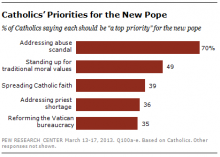
Pope Francis is creating a special commission to deal with the clergy sexual abuse crisis on a global scale, a step that comes amid growing criticism that Francis had not given sufficient attention to the scandal.
Boston Cardinal Sean O’Malley made the announcement on Thursday in the Vatican where he was meeting this week with Francis and the other members of the so-called “Gang of Eight” cardinals that the pope chose to help him reform the Roman Curia.
O’Malley, who is the U.S. bishop with perhaps the most credibility on the abuse issue, listed a range of programmatic ideas for the commission, whose members are expected to include lay people, mental health professionals, and other experts in the field as well as leading churchmen.
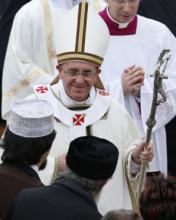
Vatican officials say reports that Pope Francis has been slipping out at night to visit the homeless in Rome are “simply not true,” though that hasn’t stopped the stories from capturing the public imagination.
That’s probably because such tales seem right in line with Francis’ unconventional and pastoral style. What’s more, the faithful always love it when a church leader sneaks under the radar to make a point — witness the fascination with the Mormon bishop who recently disguised himself as a panhandler and then revealed his identity when he climbed into the pulpit.
But breaking out of the “gilded cage” of the Vatican has been a dream of many popes and other churchmen who fear losing touch with their calling as pastors — or simply their connection to ordinary life.
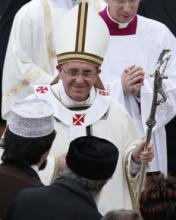
Laying out a blueprint for the issues that are likely to define his papacy, Pope Francis on Tuesday issued a biting critique of capitalism, calling on world leaders to fight against poverty and for the rich to share their wealth, and urging the media to adjust its priorities.
“How can it be that it is not a news item when an elderly homeless person dies of exposure, but it is news when the stock market loses two points?” Francis asked in an 84-page “apostolic exhortation” that is widely seen as a road map for his papacy akin to a presidential State of the Union address.
“How can we continue to stand by when food is thrown away while people are starving?” he asked. “Today, everything comes under the laws of competition and the survival of the fittest, where the powerful feed upon the powerless. As a consequence, masses of people find themselves excluded and marginalized: without possibilities, without any means of escape.”

Next week’s summit between Pope Francis and Russian President Vladmir Putin may be the most important meeting between a pontiff and a visiting head of state in nearly a quarter of a century, with war-torn Syria expected to be the top priority.
Francis has met with more than a dozen heads of state or government as pontiff, and Putin has met with both Pope Benedict XVI and Pope John Paul II. But this meeting stands out.
It’s been just four years since full diplomatic ties were re-established between Russia and the Holy See, set against a backdrop of centuries of tension between the Vatican and the Russian Orthodox Church.
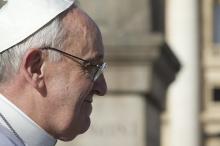
When Pope Benedict XVI retired in February, I wrote an article in appreciation for his papacy. While he served as a great model of humility in stepping down from his role as Pope, what I appreciated more about Pope Benedict was his first encyclical, turned into a book called God is Love . In it, Benedict wrote these profound words:
Love is possible, and we are able to practice it because we are created in the image of God. To experience love and in this way to cause the light of God to enter into the world — this is the invitation I would like to extend with the present encyclical. (93)
God is Love is a powerful written reminder of the essence of Christianity. I hope more Christians of all stripes will read it.
Indeed, I appreciate Benedict for writing those beautiful words, but I love Pope Francis because he’s publicly living those words.
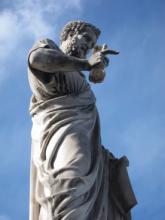
The Vatican said it would display for the first time bones believed to be the mortal remains of St. Peter, the leader of Jesus’ 12 apostles, to mark the end of the Year of Faith on Nov. 24.
Archbishop Rino Fisichella, president of the Pontifical Council for Promoting New Evangelization, wrote in Monday’s editions of L’Osservatore Romano, that the Catholic faithful making a pilgrimage to St. Peter’s tomb to mark the end of the Year of Faith will enjoy “the exposition … of the relics traditionally recognized as those of the apostle who gave his life for the Lord on this spot.”
Fisichella was referring to the long-held belief that Peter was crucified upside down and died in either A.D. 64 or 67 on the spot now marked by the Clementine Chapel inside the basilica that bears his name.
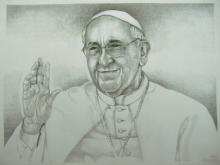
When the nation’s Catholic bishops gather on Monday for their annual fall meeting in Baltimore, one of their chief duties will be choosing a new slate of leaders to guide the American hierarchy for the next three years.
But the more than 200 prelates will also be looking over their heads — and maybe their shoulders — to the Vatican to gauge what Pope Francis’ dramatic new approach means for their future.
If Francis has made one thing clear in his nearly nine months on the job, it is that he wants the church to radically change its tone and style, starting at the top. The pontiff has repeatedly blasted careerism among churchmen and ripped “airport bishops” who spend more time jetting around the globe — and to Rome — rather than being pastors who go out to their flock and come back “smelling of the sheep,” as he likes to put it.
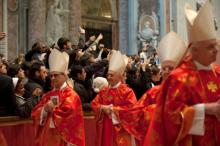
The Vatican on Monday moved to quash speculation that at least two women would be among the cardinals that Pope Francis will name in February, saying such a move was “not a realistic possibility.”
Over the weekend, Irish media reported that Francis could name Linda Hogan and Mary McAleese as cardinals. Both are associated with Trinity College in Dublin: Hogan as a professor of ecumenism, and McAleese, the former president of Ireland, as a former professor.
Some Italian media that carried the story speculated that Cecile Kyenge, the Congo-born Italian minister of integration, could be a candidate as well. Kyenge is a devout Catholic and a graduate of the Catholic University of the Sacred Heart in Milan.
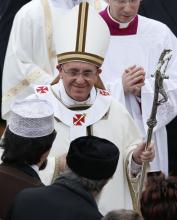
In an unusual move, the Vatican has asked the world’s bishops to quickly canvas the faithful for their views on topics like gay marriage, divorce, and birth control ahead of a major meeting of church leaders set for next fall.
But it’s not clear how or whether the American bishops will undertake such an effort, or if they will only send their own views to Rome.
The letter from the Vatican to New York Cardinal Timothy Dolan, president of the U.S. Conference of Catholic Bishops, was dated Oct. 18 and it asked that a series of questions be shared “immediately as widely as possible to deaneries and parishes so that input from local sources can be received” in time for a February planning meeting in Rome.
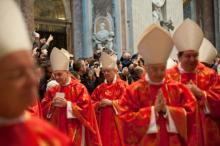
ROME — A spokeswoman for the National Security Agency denied reports from a leading Italian news magazine that U.S. spies may have listened in on conversations from inside the Vatican leading up to the March conclave that elected Pope Francis.
The newsweekly Panorama had reported in its Oct. 31 editions that the NSA tapped phones in the Santa Marta guesthouse where cardinals stayed before the conclave, as well as the cell phones of several cardinals, including Jorge Bergoglio, who became Pope Francis. The Panorama article did not identify its sources.
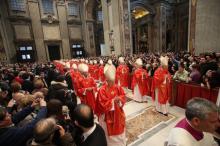
The National Security Agency spied on cardinals as they prepared to select the new pope — perhaps including even Cardinal Jorge Bergoglio, who emerged from last spring’s conclave as Pope Francis, a leading Italian news magazine reported in Wednesday’s editions.
Pope Francis still lives in the guesthouse, but the magazine did not speculate whether the phones there were still tapped.

At a speech in St. Peter's Square, Pope Francis was joined on stage by an incredibly cute young boy.
As NPR reports:
Protocol is a concept that's often lost on young children and this boy – part of a group of children invited to sit near the pontiff during a speech — didn't see any reason why he shouldn't hang out for a bit with the guy in white.
The Telegraph provides a video and this quote:
The unidentified boy refused to leave the Pope's side, clinging to his legs while two Cardinals tried to encourage him to sit back down with sweets.
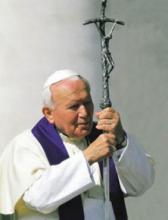
Vatican officials say they expect next year’s celebration for the canonizations of former popes John Paul II and John XXIII to be attended by as many as 100 heads of state in what is likely to be the biggest draw to the city since John Paul’s funeral in 2005.
The crowd estimates were made Tuesday, the feast day for John Paul. This will be the last time he will be venerated as Blessed Pope John Paul II; after the canonization ceremony on April 27, 2014, he will be known as St. Pope John Paul II.
John Paul’s 2005 funeral may have been the single largest gathering in Christian history, with estimates as high as 4 million mourners gathered in the Italian capital, along with at least 80 presidents, prime ministers, and monarchs.
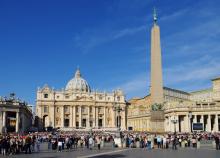
The special committee of eight cardinals created by Pope Francis with the goal of dramatically reforming the Vatican’s governance got off to an “encouraging” start, the Vatican’s chief spokesman said Wednesday, with a warning not to expect regular updates.
The Rev. Federico Lombardi said Francis met with the so-called Gang of Eight, or the Vatican G-8, on Tuesday and Wednesday to seek their counsel on possible reforms ranging from pastoral work with families and the role of the laity to the prickly issue of tackling the Vatican bureaucracy.
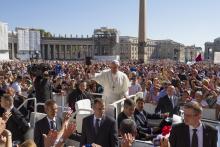
Pope Francis has once again given a startlingly candid interview that reinforces his vision of a Catholic Church that engages the world and helps the poor rather than pursuing culture wars, and one “that is not just top-down but also horizontal.”
The pope’s conversation with Eugenio Scalfari, an atheist and well-known editor of the Italian newspaper La Repubblica, took place at the pope’s residence in the Vatican guesthouse on Sept. 24 and was published on Tuesday.
His newest bombshell come just two weeks after the publication of the pope’s lengthy, groundbreaking interview with a Jesuit journalist in which Francis said the church was “obsessed” with a few moral issues, like abortion and homosexuality, and needed an “attitude” adjustment if it hopes to strike a “new balance” in its approach to the wider world.
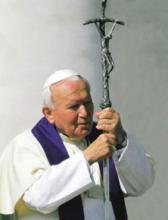
Popes John Paul II and John XXIII will be formally declared saints on April 27, 2014, the Vatican said Monday. Pope Francis made the announcement during a meeting with cardinals gathered in Rome.
John Paul, who was pope from 1978 to 2005, and John, who reigned from 1958 to 1963, are considered two of the most influential religious leaders in the world in the last century, and they represent two poles in Roman Catholicism — John XXIII is a hero to liberals, while John Paul II is widely hailed by conservatives.

Are the media pulling their punches when it comes to Pope Francis?
Whether it’s because he carries his own bags or cold-calls troubled Catholics who write to him, or because he so clearly loves interacting with crowds or drives a beat-up Renault around the Vatican, it’s hard to tell. But at some point, much of the world’s media fell for the new pope.
Now an increasing number of Vatican insiders are asking whether the largely positive view of Francis affects the way the media cover the Holy See.

Pope Francis criticized what he called the “idolatry of money” on Sunday in a trip to one of the poorest regions of the European Union.
The pontiff, visiting the island of Sardinia off Italy’s western coast, departed from his prepared remarks to talk about his own family’s struggles as Italian immigrants in Argentina. Speaking on an island where more than half of workers under 30 are unemployed, Francis told the masses: “Don’t let yourselves be robbed of hope.”
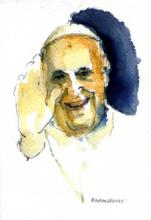
Pope Francis’ comments last week on everything from gays to abortion (less talk, more mercy), the hierarchy (be pastors, not bureaucrats), and religious faith (doubt is part of belief) continue to reverberate through the church and the media.
Here are five broader insights that this wide-ranging interview revealed about Francis — and why they will be keys to reading his pontificate, and perhaps the future of Catholicism.